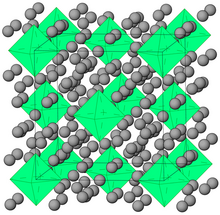Krypton compounds are compounds containing the element krypton (Kr). Krypton is usually found in the +0 oxidation state, typical of noble gases. However, Krypton can form in the +1 and +2, although this is rarely found. As +0 oxidation states cannot form compounds, Krypton's compounds, such as KrF2 are usually found in the +2 oxidation state.
Like the other noble gases, krypton is chemically highly unreactive. The rather restricted chemistry of krypton in the +2 oxidation state parallels that of the neighboring element bromine in the +1 oxidation state; due to the scandide contraction it is difficult to oxidize the 4p elements to their group oxidation states. Until the 1960s no noble gas compounds had been synthesized.[1]
Following the first successful synthesis of xenon compounds in 1962, synthesis of krypton difluoride (KrF
2) was reported in 1963. In the same year, KrF
4 was reported by Grosse, et al.,[2] but was subsequently shown to be a mistaken identification.[3] Under extreme conditions, krypton reacts with fluorine to form KrF2 according to the following equation:
Krypton gas in a krypton fluoride laser absorbs energy from a source, causing the krypton to react with fluorine gas, producing the exciplex krypton fluoride, a temporary complex in an excited energy state:
The complex can undergo spontaneous or stimulated emission, reducing its energy state to a metastable, but highly repulsive ground state. The ground state complex quickly dissociates into unbound atoms:
The result is an exciplex laser which radiates energy at 248 nm, near the ultraviolet portion of the spectrum, corresponding with the energy difference between the ground state and the excited state of the complex.


Compounds with krypton bonded to atoms other than fluorine have also been discovered. There are also unverified reports of a barium salt of a krypton oxoacid.[5] ArKr+ and KrH+ polyatomic ions have been investigated and there is evidence for KrXe or KrXe+.[6]
The reaction of KrF
2 with B(OTeF
5)
3 produces an unstable compound, Kr(OTeF
5)
2, that contains a krypton-oxygen bond. A krypton-nitrogen bond is found in the cation [HC≡N–Kr–F]+
, produced by the reaction of KrF
2 with [HC≡NH]+
[AsF−
6] below −50 °C.[7][8] HKrCN and HKrC≡CH (krypton hydride-cyanide and hydrokryptoacetylene) were reported to be stable up to 40 K.[1]
Krypton hydride (Kr(H2)4) crystals can be grown at pressures above 5 GPa. They have a face-centered cubic structure where krypton octahedra are surrounded by randomly oriented hydrogen molecules.[4]
Natural occurrence
editEarth has retained all of the noble gases that were present at its formation except helium. Krypton's concentration in the atmosphere is about 1 ppm. It can be extracted from liquid air by fractional distillation. The amount of krypton in space is uncertain, because measurement is derived from meteoric activity and solar winds. The first measurements suggest an abundance of krypton in space.[9]
See also
editReferences
edit- ^ a b Bartlett, Neil (2003). "The Noble Gases". Chemical & Engineering News. Retrieved 2006-07-02.
- ^ Grosse, A. V.; Kirshenbaum, A. D.; Streng, A. G.; Streng, L. V. (1963). "Krypton Tetrafluoride: Preparation and Some Properties". Science. 139 (3559): 1047–1048. Bibcode:1963Sci...139.1047G. doi:10.1126/science.139.3559.1047. PMID 17812982.
- ^ Prusakov, V. N.; Sokolov, V. B. (1971). "Krypton difluoride". Soviet Atomic Energy. 31 (3): 990–999. doi:10.1007/BF01375764. S2CID 189775335.
- ^ a b c Kleppe, Annette K.; Amboage, Mónica; Jephcoat, Andrew P. (2014). "New high-pressure van der Waals compound Kr(H2)4 discovered in the krypton-hydrogen binary system". Scientific Reports. 4: 4989. Bibcode:2014NatSR...4E4989K. doi:10.1038/srep04989.
- ^ Streng, A.; Grosse, A. (1964). "Acid of Krypton and Its Barium Salt". Science. 143 (3603): 242–243. Bibcode:1964Sci...143..242S. doi:10.1126/science.143.3603.242. PMID 17753149. S2CID 11607538.
- ^ "Periodic Table of the Elements" (PDF). Los Alamos National Laboratory's Chemistry Division. pp. 100–101. Archived from the original (PDF) on November 25, 2006. Retrieved 2007-04-05.
- ^ Holloway, John H.; Hope, Eric G. (1998). Sykes, A. G. (ed.). Advances in Inorganic Chemistry. Academic Press. p. 57. ISBN 978-0-12-023646-6.
- ^ Lewars, Errol G. (2008). Modeling Marvels: Computational Anticipation of Novel Molecules. Springer. p. 68. ISBN 978-1-4020-6972-7.
- ^ Cardelli, Jason A.; Meyer, David M. (1996). "The Abundance of Interstellar Krypton". The Astrophysical Journal Letters. 477 (1): L57–L60. Bibcode:1997ApJ...477L..57C. doi:10.1086/310513.


